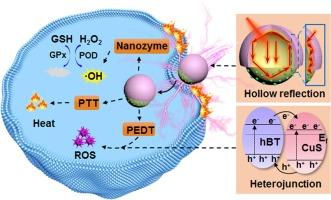当前位置:
X-MOL 学术
›
Chem. Eng. J.
›
论文详情
Our official English website, www.x-mol.net, welcomes your
feedback! (Note: you will need to create a separate account there.)
Hollow and heterojunction-structured Janus nanomotors for pyroelectrodynamic and nanozyme-catalyzed tumor therapy
Chemical Engineering Journal ( IF 13.3 ) Pub Date : 2024-11-17 , DOI: 10.1016/j.cej.2024.157763 Jie Meng, Wei Wei, Shuang Xie, Junwu Wei, Zhanlin Zhang, Pan Ran, Xiaohong Li
Chemical Engineering Journal ( IF 13.3 ) Pub Date : 2024-11-17 , DOI: 10.1016/j.cej.2024.157763 Jie Meng, Wei Wei, Shuang Xie, Junwu Wei, Zhanlin Zhang, Pan Ran, Xiaohong Li

|
Pyroelectrodynamic therapy (PEDT) has emerged as an attractive therapeutic modality for tumors, but is dramatically discounted by inherent defects of wide band gap, fast electron − hole recombination and low photothermal utilization. Herein, hollow-structured Janus nanoparticles (NPs) are developed to improve tumor accumulation and PEDT generation of reactive oxidative species (ROS) for antitumor treatment. Hollow barium titanate (hBT) NPs were prepared by the template and hydrothermal method for in situ deposition of CuS nanodots and then partially coated with polydopamine (PDA) caps to obtain hBT-CuS@PDA. Finite element analysis reveals that the unique thin shell of hBT benefits transportation of pyroelectrically generated charge carriers through shortening diffusion distance to the interface. The CuS deposition forms heterojunctions with hBT to accelerate electron − hole separation and leads to a larger pyroelectric current. The hollow structure facilitates light absorption and conversion, and the photothermal effect of the half-coated PDA caps generates asymmetric temperature gradient to drive NP locomotion across biological barriers. The in situ generated pyroelectric field selectively affects membrane potential and fluidity of tumor cells to enhance the specific NP internalization. The pyroelectric effect enhances the peroxidase-like activity of CuS nanodots to generate toxic ·OH and the glutathione peroxidase-like activity to inhibit glutathione consumption of ROS. The integration of photothermal, pyroelectric, nanozyme catalysis and self-protrusion effects promotes NP accumulation and penetration throughout tumors to exhibit therapeutic effect at a mild-temperature, reducing the possible high-temperature ablation of normal tissues. The hollow and heterjunction structure generates abundant intracellular ROS and efficient diffusion in tumor tissues to inhibit tumor growth and extend animal survival, offering a safe and effective PEDT strategy.
中文翻译:

用于热电和纳米酶催化肿瘤治疗的空心和异质结结构 Janus 纳米马达
热电动力学疗法 (PEDT) 已成为一种有吸引力的肿瘤治疗方式,但由于宽带隙、快速电子-空穴复合和低光热利用率等固有缺陷,它大大打折扣。在此,开发了中空结构的 Janus 纳米颗粒 (NPs) 来改善肿瘤积累和活性氧化物质 (ROS) 的 PEDT 生成,用于抗肿瘤治疗。采用模板和水热法制备空心钛酸钡 (hBT) NPs,用于 CuS 纳米点的原位沉积,然后部分涂覆聚多巴胺 (PDA) 帽以获得 hBT-CuS@PDA。有限元分析表明,hBT 独特的薄壳通过缩短到界面的扩散距离有利于热释电产生的载流子的运输。CuS 沉积与 hBT 形成异质结,以加速电子-空穴分离并导致更大的热释电流。中空结构有助于光的吸收和转换,半包被 PDA 帽的光热效应产生不对称的温度梯度,以驱动 NP 运动穿过生物屏障。原位产生的热释电场选择性地影响肿瘤细胞的膜电位和流动性,以增强特异性 NP 的内化。热释电效应增强了 CuS 纳米点的过氧化物酶样活性,从而产生有毒的 ·OH 和谷胱甘肽过氧化物酶样活性抑制谷胱甘肽消耗 ROS。光热、热释电、纳米酶催化和自突效应的整合促进了 NP 在整个肿瘤中的积累和渗透,从而在温和的温度下表现出治疗效果,减少了正常组织可能的高温消融。 空心和异质连接结构产生丰富的细胞内 ROS 并在肿瘤组织中有效扩散,以抑制肿瘤生长并延长动物存活,提供安全有效的 PEDT 策略。
更新日期:2024-11-20
中文翻译:

用于热电和纳米酶催化肿瘤治疗的空心和异质结结构 Janus 纳米马达
热电动力学疗法 (PEDT) 已成为一种有吸引力的肿瘤治疗方式,但由于宽带隙、快速电子-空穴复合和低光热利用率等固有缺陷,它大大打折扣。在此,开发了中空结构的 Janus 纳米颗粒 (NPs) 来改善肿瘤积累和活性氧化物质 (ROS) 的 PEDT 生成,用于抗肿瘤治疗。采用模板和水热法制备空心钛酸钡 (hBT) NPs,用于 CuS 纳米点的原位沉积,然后部分涂覆聚多巴胺 (PDA) 帽以获得 hBT-CuS@PDA。有限元分析表明,hBT 独特的薄壳通过缩短到界面的扩散距离有利于热释电产生的载流子的运输。CuS 沉积与 hBT 形成异质结,以加速电子-空穴分离并导致更大的热释电流。中空结构有助于光的吸收和转换,半包被 PDA 帽的光热效应产生不对称的温度梯度,以驱动 NP 运动穿过生物屏障。原位产生的热释电场选择性地影响肿瘤细胞的膜电位和流动性,以增强特异性 NP 的内化。热释电效应增强了 CuS 纳米点的过氧化物酶样活性,从而产生有毒的 ·OH 和谷胱甘肽过氧化物酶样活性抑制谷胱甘肽消耗 ROS。光热、热释电、纳米酶催化和自突效应的整合促进了 NP 在整个肿瘤中的积累和渗透,从而在温和的温度下表现出治疗效果,减少了正常组织可能的高温消融。 空心和异质连接结构产生丰富的细胞内 ROS 并在肿瘤组织中有效扩散,以抑制肿瘤生长并延长动物存活,提供安全有效的 PEDT 策略。


















































 京公网安备 11010802027423号
京公网安备 11010802027423号